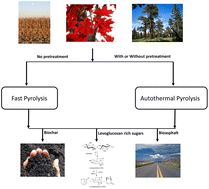Techno-economic and greenhouse gas emission assessment of carbon negative pyrolysis technology†
Abstract
Carbon-negative energy removes carbon dioxide from the atmosphere while providing energy to society. The pyrolysis-biochar platform achieves carbon-negative energy by producing bio-oil as an energy product and biochar as a carbon sequestration agent. This study evaluates the economic and environmental performance of conventional fast pyrolysis (FP) and autothermal pyrolysis (ATP) systems with and without pretreatment of three kinds of biomass to produce sugars, phenolic oil, and biochar as valuable products while achieving carbon negative emissions. Techno-economic (TEA) and life cycle analysis (LCA) results show minimum sugar selling prices (MSSP) as low as zero while achieving significant carbon dioxide removal from the atmosphere. Comparison of these systems to direct air capture (DAC) shows that the pyrolytic systems are competitive both in terms of net carbon dioxide (CO2) removal per unit of energy consumption and cost of removing CO2 which ranges between $30 to −$139 per ton CO2 removed.



 Please wait while we load your content...
Please wait while we load your content...